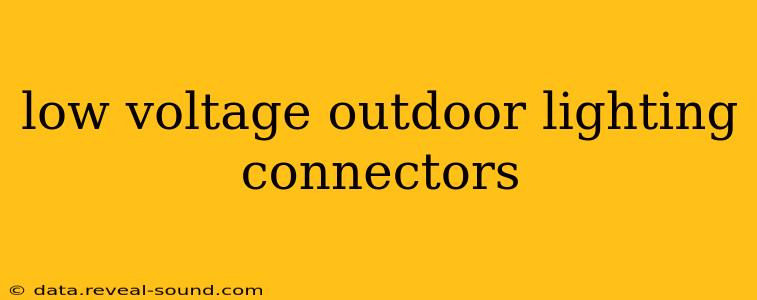Low voltage outdoor lighting offers a beautiful and energy-efficient way to illuminate your landscape. But choosing the right connectors is crucial for safety, longevity, and ease of installation. This guide will delve into the world of low voltage outdoor lighting connectors, answering your key questions and helping you make informed decisions.
What Types of Low Voltage Outdoor Lighting Connectors Are There?
Several connector types cater to low voltage outdoor lighting needs. The most common include:
-
Wire Nuts: These are the simplest and most affordable option, ideal for permanent connections within junction boxes. However, they require more technical expertise and aren't as easily disconnected for repairs or modifications. Always ensure you use appropriately sized wire nuts for the gauge of wire you're working with.
-
Push-in Connectors: These offer a quick and easy connection method, ideal for temporary setups or situations requiring frequent disconnections. They are generally more weather-resistant than wire nuts, but always check the manufacturer's specifications for outdoor suitability.
-
Waterproof Connectors: Specifically designed for outdoor applications, these connectors provide superior protection against moisture, ensuring reliable operation even in harsh weather conditions. Look for connectors with a high IP rating (Ingress Protection rating) indicating their level of water and dust resistance.
-
Quick Disconnect Connectors: These connectors allow for fast and easy connection and disconnection without the need for tools. They are particularly useful for seasonal installations or when working with multiple light fixtures.
-
Splice Connectors: These are used to join two or more wires together. Ensure you select splice connectors rated for the voltage and amperage of your lighting system.
What is the Best Connector for Low Voltage Outdoor Lighting?
The "best" connector depends on your specific needs and technical skills. For permanent installations requiring high reliability and weather resistance, waterproof connectors with a high IP rating are the optimal choice. For temporary or easily accessible installations, push-in connectors or quick disconnect connectors offer convenience. If you're comfortable with electrical work, wire nuts can be a cost-effective solution.
How Do I Choose the Right Low Voltage Connector?
Selecting the right low voltage connector involves considering several factors:
-
Wire Gauge: Ensure the connector is compatible with the gauge of wire used in your lighting system. Using an incorrectly sized connector can lead to overheating and potential fire hazards.
-
Waterproof Rating: For outdoor use, prioritize connectors with a high IP rating, ensuring protection against moisture and dust. IP67 or higher is generally recommended for complete protection.
-
Ease of Use: Consider your comfort level with electrical work. Push-in connectors or quick disconnect connectors offer greater ease of use compared to wire nuts.
-
Durability: Choose connectors made from high-quality materials that can withstand the elements and provide long-lasting performance.
Are Low Voltage Connectors Difficult to Use?
The difficulty of using low voltage connectors varies depending on the type. Push-in connectors and quick disconnect connectors are generally the easiest to use, requiring minimal tools or technical expertise. Wire nuts require more skill and knowledge of proper electrical connections. Always consult the manufacturer's instructions for detailed guidance.
How Do I Connect Low Voltage Outdoor Lighting Wires?
Connecting low voltage outdoor lighting wires depends on the chosen connector type. Always refer to the manufacturer's instructions for detailed guidance. Generally, you'll strip the insulation from the ends of the wires, insert them into the connector, and then secure the connection. For wire nuts, ensure the wires are twisted together tightly before screwing on the nut.
What Safety Precautions Should I Take When Working With Low Voltage Outdoor Lighting Connectors?
While low voltage systems are generally safer than high voltage, precautions are still essential:
-
Turn off the power: Always disconnect the power source before working with any electrical connections.
-
Use appropriate tools: Use only insulated tools to avoid accidental shocks.
-
Follow manufacturer's instructions: Always refer to the manufacturer's instructions for specific connector installation and safety guidelines.
-
Wear safety glasses: Protect your eyes from any potential hazards.
This comprehensive guide provides a solid foundation for understanding low voltage outdoor lighting connectors. Remember to always prioritize safety and choose the right connector for your specific needs and skill level. If unsure, consult a qualified electrician.
